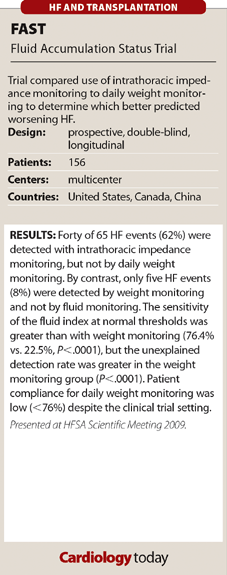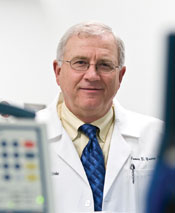Despite limitations, techniques for monitoring patients with HF are improving
Timely care, individualized treatment are some of the advantages of improved monitoring techniques.
For patients with heart failure, the monitoring of their condition outside of the physician’s office and the hospital is an essential component of their ongoing care.
Patient information for HF is gathered by technologies and techniques that, although helpful collectively, can individually paint an incomplete picture of the patient’s condition. Two of the nation’s leading experts in the field of HF indicated that HF monitoring has undergone significant development in recent years and that future developments will not only improve the quality of patient care but also lighten the disease’s financial burden.
The current standard of care for the monitoring of patients with HF is the self-monitoring of daily weight, according to William T. Abraham, MD, a professor of internal medicine at Ohio State University College of Medicine in Columbus. Although inexpensive, daily weight monitoring tends to have inherent problems such as lack of patient compliance and an inability to successfully predict worsening HF or HF events with regularity.
|
Source: Cleveland Clinic, Communications Department |
“We now have many studies that demonstrate that the sensitivity of daily weight monitoring for predicting episodes of HF decompensation requiring hospitalization is on the order of 10% to 20%,” Abraham told Cardiology Today. “We have a standard of care but it is a poor standard, and we need to continue to develop better ways of monitoring our HF patients to keep them out of the hospital.”
Researchers are exploring new ways to improve the standard of care. Abraham cited results from FAST, recently presented at the Heart Failure Society of America’s annual scientific meeting in Boston. The results suggested that the measurement of intrathoracic impedance with an implanted monitoring device was superior to daily weight monitoring for the prediction of worsening HF (see scorecard below).
“Recently, the real innovations have been in trying to find better ways of assessing when patients are becoming decompensated or congested, and intrathoracic impedance monitoring is one way to do this,” Abraham said. “Having said that, it is definitely better than daily weight monitoring, but daily weight monitoring is not a very good standard. We need improvements here.”
Effective monitoring in patients with HF requires the synthesis of a variety of measurements as well as the transmission of the information gathered. Information obtained by self-monitoring can be sent to the physician by the patient, and in the case of modern implanted devices, the information can be transmitted automatically to either a third-party assessor or directly to a physician’s office for processing.
Some measurements require the patient to interact directly with the physician. The monitoring of biomarkers such as brain natriuretic peptide levels can predict worsening HF, although this requires the patient to visit the clinic and have blood drawn.
“For a while, the serial monitoring of BNP and related biomarkers gave us some hope, but that has been a checkered experience,” James B. Young, MD, a professor of medicine at the Cleveland Clinic Lerner College of Medicine of Case Western Reserve University and a section editor for the HF and Transplantation section of the Cardiology Today Editorial Board, said in an interview. “There have been many observations that have suggested serial BNP measurement is important, yet there have been some observations that are not quite as exciting and data not so enthusiastically in support of that approach.”
Other measurements commonly evaluated in the ongoing assessment of patients with HF include fluid and filling pressures in the heart, BP and heart rate. Young also stressed that pulmonary artery pressure is essential for the prediction of detrimental outcomes.
“Devices that give an indirect reading of what the pulmonary artery pressure is (and by indication, pulmonary capillary wedge pressure) and then can telemeter that information, are extremely valuable,” Young said.
Abraham added that modern telemonitoring technology also allows information to be transmitted not only to the physician’s office but also directly to portable handheld communication devices.
“With one of the investigational devices we are working with, I actually get an alert sent to my iPhone that tells me the patient’s pressure has risen above a critical level, but I do not hear about other patients as long as they are within acceptable ranges,” he said. “This is essentially management by exception, so that if you have hundreds or even thousands of HF patients with various sorts of monitoring devices, the ones you are going to address are the few patients who fall outside of some range of normalcy or desired range for that particular patient.”
Evolving approval standards
Information gathered from either patient self-monitoring or from implanted monitoring devices is not only essential for the proper management of the patient but also for the planning of new clinical trials for monitoring devices and techniques. The definition of meaningful clinical endpoints, Abraham noted, is an important consideration for future research in the field of HF monitoring. Variables such as outpatient episodes of worsening HF, extra medication given to patients discharged from the hospital, and the overall course of the patient’s disease were among some of the real-world complexities Abraham said deserved more attention in clinical trials.
“In past monitoring studies, we generally have not tended to look at hard outcomes, but we need to,” he said. “Instead of waiting until patients develop worsening symptoms, we can enable a proactive approach so that through daily monitoring, we can essentially keep the fluid levels and filling pressures right on a day-to-day basis.”
Abraham said that the standards for the FDA approval of HF monitoring devices have been raised in recent years, particularly for implantable devices, and that the regulatory emphasis is now oriented toward outcomes.
“It used to be good enough if you had an implantable hemodynamic monitor and showed that it measured the same thing as a Swan-Ganz catheter, but that is not good enough anymore,” Abraham said. “We now do not only want to know that hemodynamic monitoring or weight or impedance correlate to a Swan-Ganz catheter but we also want to know that our knowledge and our actions based on that information allow us to keep patients well and out of the hospital. The field has moved away from validating the goodness of the diagnostic device based on its correlation to some other measure and is now on to looking at outcomes.”
Potential effect on health care costs
Hospitalization for HF and its related complications is a major public health issue in the United States. According to Abraham, statistics suggested that 1.2 million patients were hospitalized in 2008 with a primary diagnosis of HF and that the 30-day readmission rate for HF in the Medicare population is 27%. Abraham also said that although data were still being collected, some study results suggested the improvements in monitoring could ultimately cut readmissions for HF between 20% and 50%.
Young and Abraham said improved monitoring techniques and technologies, coupled with better-designed trials and higher-quality patient data, could help reduce health care costs incurred from HF hospitalizations.
“As we see the aging population and the increasing risk for HF, you do not have to keep too many patients out of the hospital to be able to save a whole lot of dollars,” Young said. “Coming up with reliable devices that will give you information that will aid in predicting adverse events and will allow you to intervene before those events occur is going to be extraordinarily important.”
Abraham added that although higher-quality patient information could also aid in the prevention of HF–related complications and help keep patients out of the hospital, the same information could also be used to proactively hospitalize a subset of patients whose conditions necessitate more aggressive monitoring.
“We have seen that although these approaches can help us manage and keep a large number of them out of the hospital, there are patients who have HF that is refractory to standard therapies,” Abraham said. “In general, the goal is to keep patients well compensated and out of the hospital, but we can also use the information to identify more quickly the patients who need left ventricular assist devices, transplants or more advanced therapy.”
Despite ongoing research and the need for improvements in technologies and data-gathering techniques, Young sees the field of HF monitoring as much improved in recent years and moving in the right direction.
“People have been focusing on this field for at least a decade, and there have not been a whole lot of conclusive answers coming forward,” he said. “However, we are closer than ever before to figuring out how to do effective remote monitoring, and the remote monitoring tools are vastly better today than they have ever been before.” – by Eric Raible


